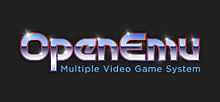OpenEmu
 | |
| Original author(s) | Josh Weinberg |
|---|---|
| Developer(s) | OpenEmu Team |
| Stable release | 1.0.1 |
| Written in | Objective-C |
| Operating system | Mac OS X |
| Size | 16.6 MB |
| Available in | English |
| Type | Video Game Emulator |
| License | BSD |
| Website | openemu.org |
OpenEmu is an open source multi-system game emulator designed for Mac OS X. It provides a plugin interface to emulate several consoles' hardware, such as the Nintendo Entertainment System, Sega Genesis, and many more. The architecture allows for other developers to add new cores to the base system without having to worry about specific OS X APIs.
As of December 28, 2013, OpenEmu has been downloaded over 200,000 times since its version 1.0 release, making it one of the most popular multi-system emulators on OS X.[1]
History
OpenEmu first started in 2007 as OpenNestopia, a port of the NES/Famicom emulator Nestopia done by Josh Weinberg.[2] Weinberg and his friend, Ben Devacel, began searching for more developers to port other emulators to OS X, which led to the name change to OpenEmu, to better describe the multi-system emulator.[3]
Features
OpenEmu features a backend that uses multiple game engines while maintaining the familiar, native OS X frontend UI. It also uses modern OS X technologies such as Cocoa and Quartz.[4] A unique feature of OpenEmu is its ROM library, which allows one to import ROM files and view them in a gallery type setting. Game info and cover art can be added from OpenEmu's databases.
OpenEmu includes the following features:
- High-quality OpenGL scaling, multithreaded playback, and other optimizations[5]
- Real-time 3D effects and image processing
- Graphic filters to enhance display
- Full-screen support
- Ability to play multiple ROMs at once
- Ability to scan attached disks for ROMs
- Automatic downloading of game info and cover art
- A fully featured library, supporting multiple views (including Cover Flow), collections (categories), and game ratings
- Optional automatic organization of ROM files within the library folder
- Full save state support, including automatic save states
- Enhanced gamepad support
Supported systems
| System | Based on code from | License |
|---|---|---|
| Game Boy / Color | Gambatte | GPLv2 |
| Game Boy Advance | VisualBoyAdvance | GPLv2+ |
| Nintendo DS | DeSmuME | GPL |
| Neo Geo Pocket / Color | Neopop | GPLv2+ |
| Nintendo Entertainment System | FCE Ultra and Nestopia | GPLv2 GPLv2+ |
| Super Nintendo Entertainment System | bsnes and snes9x | GPLv3 MIT with Non-commercial clause, LGPLv2.1, GPLv2+ |
| Sega Genesis | Genesis Plus | GPL |
| Sega Master System and Game Gear | CrabEmu | GPLv2 |
| Sega 32X | Picodrive | MAME[6] |
| Turbografx-16 and Virtual Boy | Mednafen |
Reception
ArsTechnica says that "OpenEmu's controller configuration interface is both snazzy-looking and functional, and it gives you a nice, high-resolution visual representation of the controller you're configuring."[7]
The Verge tells readers how to “Play classic video games in style with OpenEmu for Mac."[8]
Game archive website The Archive says that "OpenEmu brings the idea of an emulator for a mainstream, general audience to reality".[9]
See also
References
- ↑ "Github OpenEmu Release Download Stats".
- ↑ "OpenNestopia".
- ↑ "The Archive - An Emulator for the Rest of Us—How OpenEmu Changes Everything".
- ↑ "MacScene Listing".
- ↑ "Create Digital Motion".
- ↑ http://notaz.gp2x.de/cgi-bin/gitweb.cgi?p=picodrive.git;a=blob;f=COPYING;h=c0f5a3ca8346a5d12bc1a66214ff208aadc0abc0;hb=HEAD|title=MAME license
- ↑ "ArsTechnica OpenEmu Hands On".
- ↑ "The Verge OpenEmu Review".
- ↑ "OpenEmu feature on The Archive".